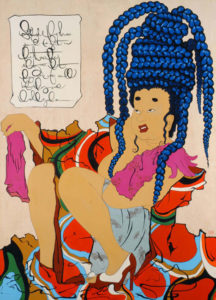Bling Blasian Bling: Iona Rozeal Brown and Stella Lai at the Luggage Store
This piece was published as a “Critic’s Choice” Column in the Bay Guardian. It can be cited here as: Buckner, Clark. “Blasian Bling: Iona Rozeal Brown and Stella Lai at the Luggage Store,” WEB. www.clarkbuckner.com. Date, month, and year, it was downloaded.

At the turn of the Millennium, Japan witnessed the emergence of a subculture of teenage girls, known as “ganguro” or “black face,” who braid their hair in cornrows, adorn themselves in “bling-bling,” and mimic Missy Elliot. Iona Rozeal Brown took these ganguro as her muse in her contribution to The Luggage Store’s exhibition, Bling BlAsian Bling. She staged the hip-hopification of Japanese culture through a series of paintings in the style of 17th and 18th- century woodblock prints, in which what otherwise appear to be traditional figures from Japanese art, including geishas and courtesans, were transformed by the conventions of hip-hop culture. Their skin was turning brown. Their bodies were voluptuous. And they were sporting the styles of African-American hipsters. A woman with redish-black braids squeezed her heavy brown tit, played with her excessively long nails, and licked her lips like Lil’ Kim. A man with dreadlocks had his boxer shorts sticking out of the top of his pants. He scowled, grabbed his jock, and drank from a studded challis, while a woman with an Afro and heavy jewelry kneeled before him smoking a blunt.
The paintings drew upon the surprising stylistic affinities between these two
disparate cultures, revealing a common grace in the graffiti line and calligraphic brush-stroke, along with a common cultural object in the decorated, subservient woman. But Brown also treated the confluence of the two cultures as absurd, employing the juxtaposition of the ancient and the modern, the Japanese and the African-American, as a Brechtian alienation affect to explore the comodification
of racial identity.
Brown’s paintings examined the reduction of “blackness” to a fetish-object subject to appropriation across cultural lines. Her portrayal of the ganguros as monstrous figures betrayed her resentment of their identification with hip-hop culture. At the same time, she treated hip-hop itself as a grotesque brand of consumerism. Her paintings were often infested with worms drawn in the style of graffiti art, which feasted on her figures like a scourge on the traditional Japanese ideal of beauty. Brown’s figures were both avatars of a new cultural pluralism and grotesque, racist caricatures of consumer society. Through their hyper-stylization, they worked to articulate the contradictions of globalized culture embodied in the “ganguro.”
Bling BlAsian Bling also included a series of colorful, highly graphic paintings by Stella Lai, which juxtaposed flowers, patterns, and urban landscapes inhabited by tiny girls wearing animal masks. The paintings appeared to tell stories and to hint at an ambivalence between innocence and vice. What they were doing in a show titled, Bling BlAsian Bling, I don’t know.
